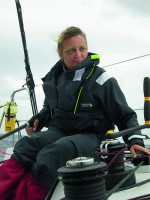A great alternative for crews with less muscle power outside gybing an asymmetric can be less risky than an inside gybe – if you practise, says Pip Hare
Outside gybing is not purely reserved for boats with extra-short poles or top notch race crews. If you practise, it can be less risky than pulling the clew inside the luff and is a great alternative for crews with less muscle power.
The key to success is to ensure the spinnaker flies out freely, like a flag, so the clew passes directly in front of the boat. Picture steering the boat around the sail, rather than pulling the sail around the boat.
Leading into the gybe, steer a course that ensures you keep enough pressure in the spinnaker to blow the clew forward; in lighter airs you may need to sail higher to achieve this. You need excellent timing for the release of the old sheet – have someone on the helm rather than use the autopilot.
Let the crew call the manoeuvre as they are able to judge the pressure in the sail and if need be can direct the helmsman to come up before the gybe.

Allow the sheet to fly and the clew to go forward
Prepare your spinnaker sheets with care. The clew must fly out from the boat and around the front in one clean movement. Pull the tackline on fully to reduce the risk of a wrap.
When you are ready, spin the old spinnaker sheet off the winch, simultaneously steering rapidly downwind so the spinnaker ends up streaming directly ahead. Steering too slow or too soon, insufficient pressure in the sail or the sheet snagging can cause the clew to be pulled back towards the luff, allowing the spinnaker to fold up in a wrap.
Practise for good timing
Practise releasing the sheet to learn how quickly to turn the boat and what pressure is required in the sail. The helmsman must keep an eye on the spinnaker and actively steer to blow the clew forward.
If it starts to go wrong, cancel the gybe, head up and pull the sail back in on the old side; it is very hard to recover the gybe if the release is hampered.

Pull on the new sheet when the clew has passed the bow
Once the clew has passed directly in front of the boat and over to the new side, start to pull in on the new sheet. Do not be tempted to sheet in if the sail is still inside out. The mainsail should gybe as the clew passes round the front of the boat and at this point the rate of turn can be slowed down.
Now it is less critical to keep someone on the helm, so the autopilot could be activated, allowing an extra pair of hands to manage the mainsail.

Take in sheet as quickly as you can manage
Once the main has gybed, steer the boat up to a broad reach. Do this even if the spinnaker is not yet in as it will blow the clew to leeward and so reduce the risk of a wineglass. At this point the autopilot can take over in true wind mode so the helmsman can get stuck into grinding a winch.
There is no easy way to pull in the sail. But so long as the clew is blowing out to leeward there is little risk of wrapping the spinnaker so, if you have a weaker crew, steer the boat on more of a reaching course and wind the sail in your own time – it is not fast, but it gets the job done.
Step by step
- The clew must be allowed to fly out in front of the boat.
- Do not attempt to pull the clew round if the sail is inside out.
- Tack batten prodders help stop the lazy sheet from falling under the pole.
- The crew is best placed to call the gybe as they can feel the pressure in the spinnaker sheets.
Quick tips
- Splice lightweight tails to the end of your spinnaker sheets to give the extra length required for this gybe.
- Stick glow-in-the-dark tape to the clew for gybing in the dark – choosing a white spinnaker will help too.
- In very light airs the clew may not blow round so re-reeve your sheets and pull the clew round inside the spinnaker luff instead.
- Measure your spinnaker sheets to check they are long enough for the clew to pass round the front of the boat with the spinnaker foot at full stretch.

Single-handed ocean sailor Pip Hare has clocked up thousands of miles racing and cruising. Among her achievements are five solo transatlantics, including the OSTAR and two Mini Transat races. She also works full-time for the RNLI on sea safety and is Consulting Editor on Yachting World. See her gear test on weather routeing packages
See also Pip’s fascinating series on advanced sailing techniques: SAIL FASTER SAIL SAFER




